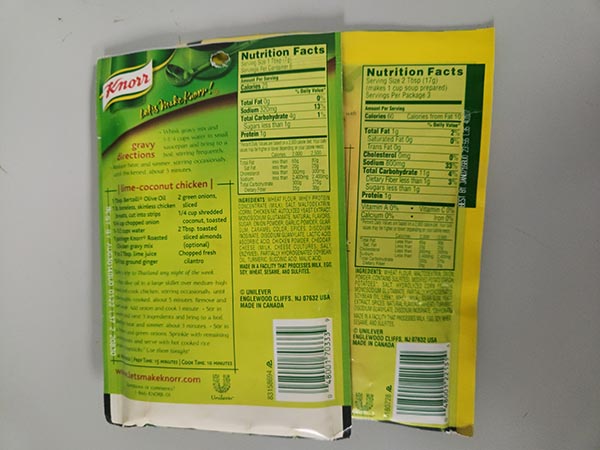Knorr brand sauce and gravy mixes make a great shortcut if you don’t have the time, the culinary skill, the ingredients, or the patience to make your own pesto, hollandaise sauce or chicken gravy. They are rather heavy on salt, corn starch, and monosodium glutamate, meaning their market focus must be on an older demographic rather than health-conscious young folk who carefully read ingredients.
That’s one of only two plausible explanations for the ingredients, recipes, and preparation instructions on the package being printed in 4 point type, Optima face, green on green. No one over the age of 30 can read the package.

Might the company have intentionally obscured its nutritional information? I think this unlikely, since serving instructions and recipes were subjected to the same treatment.
Unfortunately, the other explanation is carelessness. Some designer dreamed up the style. My guess is that after it was approved the type size was reduced to fit all the great marketing copy onto the small envelope in which the product is packaged. Some printer is probably proud that he was able to resolve the tiny, thin typeface without plugging, not worrying that it was unreadable without a magnifying glass.
This is a great opportunity for a package printer, the last line of defense, to alert his client of their mistake. The combination of font size, type face, and color choice make the package virtually unreadable, which should be no different than discovering a typo or a low-res graphic.
Here’s a great chance to add value and demonstrate your professional acuity even if you haven’t been involved in the creative process.
***
Many people assume that Gutenberg’s Bible which printed in German. In fact, the translation typeset and printed by Gutenberg was St. Jerome’s Latin Vulgate. Working 63 years before the Reformation rocked Germany, Gutenberg’s project had the full blessing of the Roman Catholic Church.
Does anyone remember what Gutenberg did to follow up his famous Bible project? His second publication was De Officiis or “On Duties,” the final work of Roman Republican statesman Marcus Tullius Cicero. It was also printed in Latin.
Today, Gutenberg, his movable type, and his printing press are universally haled as the single biggest influence on the evolution of Western Civilization. Ironically, neither Latin, nor the Bible, nor the works of Cicero, are taught in today’s Ivy League universities, which also seem determined to eliminate the printed textbook. So much for Western Civilization.
***
“The cost of accommodating the dilettante is a demeaning of expertise.” —Nicholas Carr in The Glass Cage
***
My nephew likes to needle me about my love of all things printed and paper, so I take pleasure in using printed materials to acknowledge his birthday. One year I sent him a telegram, much to his shock.
Yes, telegrams are alive and well, thanks to sendtelegram.com who picked up the slack after Western Union exited the business. For as little as $30 you can send a “wire” which will be printed out and hand delivered by courier in a sealed envelope, usually same day.
Congratulatory telegrams such as mine are a relatively small portion of their business. Their biggest single niche is cancellation notices, which must be served within a time window specified by contract. The hand-delivered printed telegram satisfies the contractual demand for cancellation to be served in writing.
This is a great example of the marrying of modern and traditional technology, combining the convenience of the internet with the effectiveness of print.
Food for thought the next time you need to get someone’s attention.














